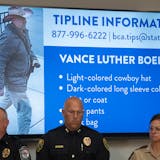A barbaric form of American racial terrorism from another era — lynching — was in the news twice this week. Presidential crony Roger Stone incorrectly appropriated the term to describe his current legal problems, while "Empire" actor Jussie Smollett was allegedly beaten in Chicago by two attackers. Smollett reportedly was left with a rope wrapped around his neck.
Sadly, these incidents make timely my latest interview with the inestimable, thoughtful Bryan Stevenson, social justice attorney and force behind the lynching monument in Montgomery, Ala., which opened last April. Stevenson, founder of Equal Justice Initiative, a center for legal defense and social advocacy, has been a one-man economic development boon for Alabama's capital city. Among other projects, Stevenson guided the creation of the Legacy Museum and the National Memorial for Peace and Justice, the official name of the lynching monument. Located in a warehouse where blacks were enslaved, the Legacy Museum traces how America has gone from keeping blacks in slavery to packing the world's largest prison system with them. During a visit to the museum, I observed a tall white man, in an expensive suit and wingtips, so transfixed by what he was reading that he could not move.
I first interviewed Stevenson after his sold-out appearance last June at the Minneapolis Institute of Art. We didn't get through all of my questions because I had only three minutes. Stevenson was not able to fit in another interview when he returned to the Twin Cities in November for another sold-out appearance, this time at Edina's Christ Presbyterian Church.
Stevenson finally gave me a follow-up interview during a recent trip I made to Alabama, where his sites are doing more for Montgomery's tourism than all the monuments to the Confederacy. This is the first of two parts of our discussion.
Q: In the grand scheme of things where does removing symbols of the Confederacy rank with your priorities in the pursuit of racial justice?
A: I think it's important. I do think we want to create a consciousness among more people about why they [the symbols] should come down because if we just take things down because we get the power to do so, it doesn't actually achieve the kind of advancement and thinking that I think we need to have. In many ways things changed in the civil rights era because the courts forced them to, and that was the right thing to happen.
But we didn't engage in the kinds of conversations that actually change people's thinking. Now we have this re-segregation, a whole new generation of problems that a lot of people thought we were going to eliminate in the 1960s. As we deal with this history, I think we need to develop a consciousness that makes us understand why if people did dishonorable things, destructive things, if they defended slavery, we shouldn't honor them.
Q: Do you feel that progress toward racial justice is actually taking place in Alabama?


